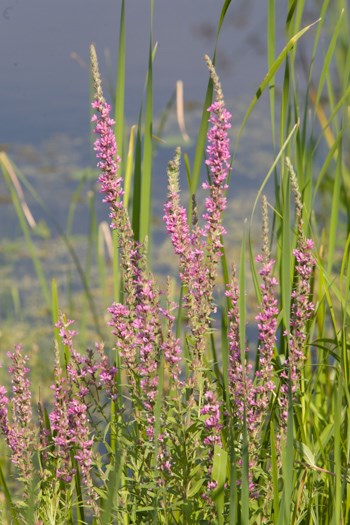
NPS/Gordon Dietzman Wetlands Home | Invasive Plants IntroductionThe purple loosestrife is a perennial herb with a square, woody stem. The stem can grow as tall as four to ten feet depending on the condition of the area. Along the stem, leaves grow opposite of each other, usually in twos, and sometimes threes. Leaves are long and thin, with little or no stem. Each flower has five to seven magenta petals, with a yellow center. Flower spikes have multiple flowers on them. Purple loosestrife chokes out other plants with its extensive root structure which has anywhere from 30 to 50 shoots. Purple loosestrife is a native of Eurasia, from Great Britain across the two continents to Japan. Introduced during the 1800's to northeastern U.S. and Canada to be use as ornamentals and medicinal purposes, purple loosestrife spread across the continent. In many places today, except Minnesota, Wisconsin, and Illinois, purple loosestrife is still widely sold as an ornamental. The purple loosestrife adapts readily to different types of wetland environments such as freshwater wet meadows, pond edges, reservoirs, ditches, tidal and non-tidal marshes, and river and stream banks. According to the U.S. Fish and Wildlife Service, purple loosestrife now occurs in every state except Florida. With an extended flowering period from June to September, a single purple loosestrife plant can produce up to 2.7 million seeds. Seeds are small and can be easily dispersed by water, wind, wildlife, and humans alike. Some seeds germinate the following season, but others may lay dormant for several more seasons. The flowers do not require insects to pollinate them. Once purple loosestrife is established, it will expand and out-compete other plants in the area. Purple loosestrife forms dense, homogeneous stands blocking out native plants and reducing habitat for waterfowl. Native plants that were once the home or food source of native wildlife are destroyed, causing wildlife populations to decrease or to move to uninfested areas. Blooms: June and July Want to Help Us Better Understand the Park?See our iNaturalist project, "The Life of the Mississippi National River and Recreation Area" and contribute to it by downloading the iNaturalist app and uploading your sightings of this species, and others, to the project. You can also upload your sightings from your computer. |
Last updated: March 22, 2018
